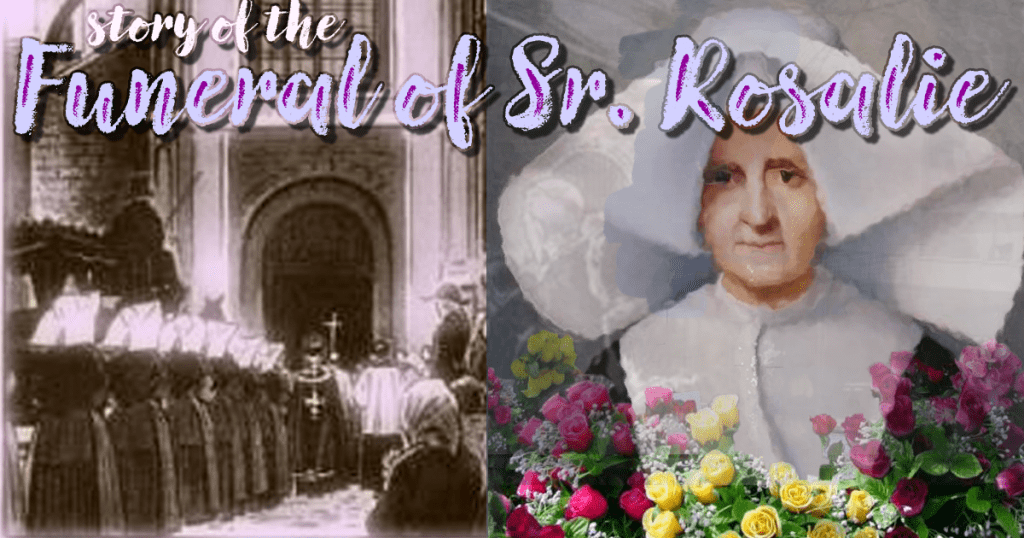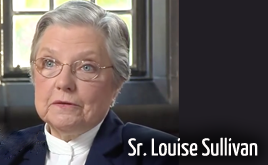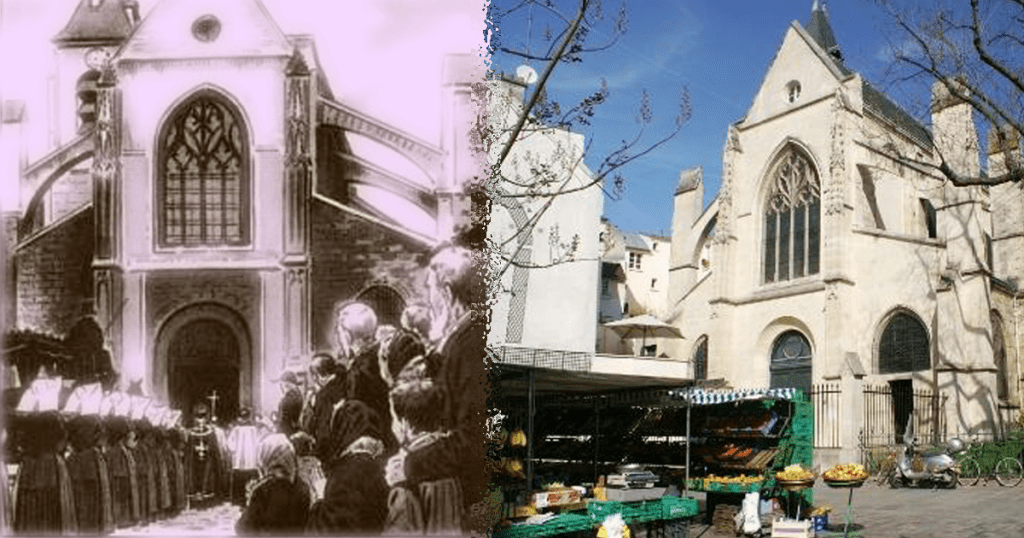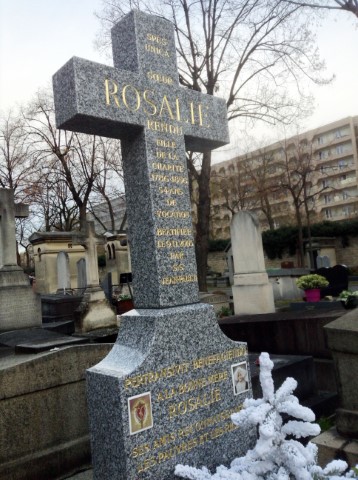 This Wednesday is the anniversary of the beatification of Rosalie Rendu, D.C. She was beatified on Nov. 9, 2003 by Pope John Paul II. In celebration I would like to share several excerpts from the book by Sister Louise Sullivan, D.C.: “Sister Rosalie Rendu: A Daughter of Charity On Fire with Love for the Poor.” This first passage is the wonderful account of Sister Rosalie’s funeral. This is not one of those grandiloquent legends of the Saints that has become embellished over time, as unfortunately happens in some cases. It is told by Viscount Armand de Melun, who was there at the funeral. As Sr. Louise explains, “…he knew Sister Rosalie very well. She had been his mentor and support for 20 years… Melun had weekly direct contact with Sister Rosalie… [He also] knew her companions and some of her other collaborators, thus eyewitnesses were available to him.” Sr. Louise begins Chapter 14 of her book:
This Wednesday is the anniversary of the beatification of Rosalie Rendu, D.C. She was beatified on Nov. 9, 2003 by Pope John Paul II. In celebration I would like to share several excerpts from the book by Sister Louise Sullivan, D.C.: “Sister Rosalie Rendu: A Daughter of Charity On Fire with Love for the Poor.” This first passage is the wonderful account of Sister Rosalie’s funeral. This is not one of those grandiloquent legends of the Saints that has become embellished over time, as unfortunately happens in some cases. It is told by Viscount Armand de Melun, who was there at the funeral. As Sr. Louise explains, “…he knew Sister Rosalie very well. She had been his mentor and support for 20 years… Melun had weekly direct contact with Sister Rosalie… [He also] knew her companions and some of her other collaborators, thus eyewitnesses were available to him.” Sr. Louise begins Chapter 14 of her book:
 Sister Rosalie was buried from the church of Saint-Médard on 9 February 1856. She was 70 years of age and 54 years of vocation. Nearly her entire life as a Daughter of Charity had been spent in the Mouffetard district. Thus, it was not surprising that her “beloved poor,” who had waited hours in line to view her mortal remains and pay final tribute to their “Mother,” would close their modest businesses or leave their work to accompany, to her final resting place, “the woman who, for such a longtime, had been the instrument of Providence … in their lives.”* According to Sister Saillard, who was present, they numbered 60,000.* Others place the number at 40 or 50,000.
Sister Rosalie was buried from the church of Saint-Médard on 9 February 1856. She was 70 years of age and 54 years of vocation. Nearly her entire life as a Daughter of Charity had been spent in the Mouffetard district. Thus, it was not surprising that her “beloved poor,” who had waited hours in line to view her mortal remains and pay final tribute to their “Mother,” would close their modest businesses or leave their work to accompany, to her final resting place, “the woman who, for such a longtime, had been the instrument of Providence … in their lives.”* According to Sister Saillard, who was present, they numbered 60,000.* Others place the number at 40 or 50,000.
Church of Saint Médard, then and now. Present-day photo shows a produce stand, the Rue Mouffetard Market. Today’s touristy neighborhood with its shops and cafés is a far cry from the misery in the district at the time of Sr. Rosalie.
The accounts of the ceremony are nearly identical. We will rely on newspaper reports following the funeral and especially on Melun, as he was in attendance. Descriptions in later biographies are based on his. Amidst his grief and personal sense of loss, his eye recorded for posterity all that was happening around this humble Daughter of Saint Vincent as she left the Mouffetard district for the last time. He recounts the extraordinary event:
At 11 o’clock, the cortège left the house; … the clergy of Saint-Médard, joined by a large number of ecclesiastics [and representatives of religious orders], walked at the head [of the procession], preceded by the cross [which was permitted to be on public display because of the occasion]; the girls from the school and the workshops honored the works of their Mother; the Sisters of Charity surrounded the casket [that had been] placed on the hearse of the poor, as Sister Rosalie had requested, so that Saint Vincent de Paul could recognize her, to the end, as one of his Daughters. They were followed by the municipal administration and the [administrators of the] Bureau of Public Assistance of the XIIth arrondissement. Behind them, crowded together, was one of those multitudes that can neither be counted nor described, from every level of society, every age-group, and every profession; an entire people with its rich and its poor; its intellectuals and its workers; everything in it that was most illustrious and most obscure; all mixed in together, all mingling and expressing in diverse manners and different words the same sorrow and the same admiration. All came to express their gratitude for a service rendered or to praise… [Sister Rosalie] and to convey their last respects. One could say that the holy deceased had made an appointment, around her coffin, with all those she had visited, assisted, and counseled during the long years of her life. Moreover, she still exercised the influence of her presence and her words over them, as these men [and women], belonging to the most widely [diverse sectors] of society, separated by their education, their ideas, and their positions, who perhaps never met until now except to clash, were united that day in the same thought and the same recollection.**
Sister Rosalie’s funeral was a testimony to her genius for uniting men and women, who had little else in common, in the pursuit of the Vincentian mission of service to those who were poor. Melun describes this exceptional scene in a very polarized society, “Factions vanished; hatreds dissipated; passions were stilled. There were only brothers [and sisters] and children who were accompanying their sister and mother to her final resting place.”***
*Sacra Congregatio Pro Causis, Rendu, Positio; Sommaire, 67. **Melun , Vie de la soeur Rosalie , 246-247. ***Ibid, p. 247.
Couldn’t we use a dose of this today!
Stay tuned – on Sunday night we will post another excerpt from “Sister Rosalie Rendu: A Daughter of Charity On Fire with Love for the Poor” (2006). Sullivan, Louise D.C. Vincentian Digital Books. Book 5.

Tomb of Sr. Rosalie







How Beautiful this Account is of The Ways we can all Colllaborate in many Varied Ways. All for the Love ❤️ of our Friends And Neighbors in Need . In turn elevating More Suffering as Rosalie knew in Her Heart. Translate to These Times LIve in LOVE Unselfishness but always being Thankfull for our Gifts and Treasures all Granted in Graces from our Lord And Savior.